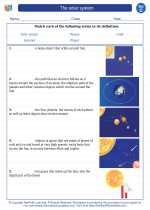The Solar System
The solar system is a collection of celestial bodies that are bound together by gravity. It consists of the Sun, eight planets, moons, asteroids, comets, and other objects.
The Sun
The Sun is the center of the solar system and the largest object. It provides light and heat to the planets and other celestial bodies. It is a massive ball of hot gases, primarily hydrogen and helium.
The Planets
There are eight planets in the solar system, divided into two groups: terrestrial planets (Mercury, Venus, Earth, and Mars) and gas giants (Jupiter, Saturn, Uranus, and Neptune). Each planet has its own unique characteristics and features.
Moons
Many of the planets in the solar system have moons (or natural satellites) orbiting around them. For example, Earth has one moon, while Jupiter has over 70 moons.
Asteroids and Comets
Asteroids are rocky objects that orbit the Sun, mostly found in the asteroid belt between Mars and Jupiter. Comets are icy bodies that travel through the solar system, leaving a trail of gas and dust behind them when they approach the Sun.
Studying the Solar System
There are various ways to study the solar system, including telescopes, space probes, and spacecraft missions. Scientists continue to make new discoveries and learn more about the solar system and beyond.
Study Guide
- What is the center of the solar system? The Sun
- How many planets are there in the solar system? Eight
- Name the four terrestrial planets. Mercury, Venus, Earth, Mars
- What are asteroids and where are they mostly found? Asteroids are rocky objects found mostly in the asteroid belt between Mars and Jupiter
- What are comets and what do they leave behind when they approach the Sun? Comets are icy bodies that leave a trail of gas and dust behind them when they approach the Sun
◂Science Worksheets and Study Guides Third Grade. The solar system
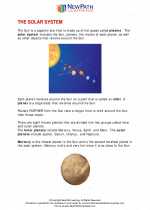
 Activity Lesson
Activity Lesson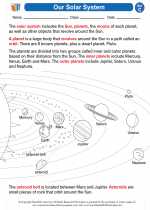
 Worksheet/Answer key
Worksheet/Answer key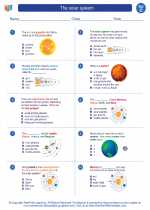
 Worksheet/Answer key
Worksheet/Answer key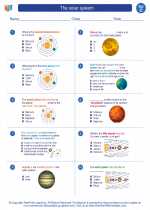
 Worksheet/Answer key
Worksheet/Answer key
 Worksheet/Answer key
Worksheet/Answer key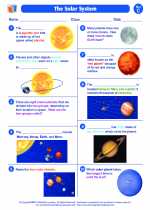
 Vocabulary/Answer key
Vocabulary/Answer key